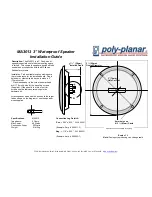
38
9 Installation
9.1 Installation general
Reliable and accurate operation of an Autopilot depends more on correct installation than
any other piece of marine electronics. Please read and fully understand the installation
requirements before attempting installation.
Note! If in doubt, obtain the services of an experienced Autopilot installation
technician.
•
The installation includes 8 major steps:
1. Read the installation and operation manual.
2. Plan where to install the different parts.
3. Make the attachments needed for Pumpset and Cylinder and install them.
4. Run the cables.
5. Install the transducers and instruments.
6. Take a break and admire your installation.
7. Learn the functions and calibrate your systems.
8. Make the Dockside Testing before the Sea Trials.
Before you begin drilling ...
think about how you can make the installation as neat and
simple as your boat will allow. Plan where to position the transducer and the instrument.
Think about leaving space for additional instruments to be fitted in the future.
A few "do nots" you should consider:
•
Do not cut the cables too short. Allow extra cable length at the instrument so it can be
disconnected for inspection without having to disconnect all attached cables.
•
Do not place sealant behind the instrument. The gasket eliminates the need for sealant.
•
Do not run cables in the bilge, where water may accumulate.
•
Do not run cables close to fluorescent light sources, engine or radio transmitting
equipment, in order to avoid possible electrical disturbances.
•
Do not rush, take your time. A neat installation is easy to do.
The following material is needed:
•
Wire cutters and strippers
•
A pair of flat pliers
•
Small and large Philips and flat head screw driver
•
Hole saw for the instrument clearance hole 50 mm (2”)
•
Drill for the mounting holes (2,8 mm 0,11” for the instrument)
•
Cable ties
INSTALLATION












































